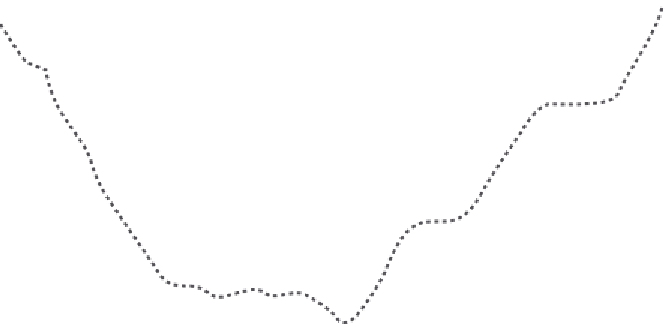Environmental Engineering Reference
In-Depth Information
TABLE 17.2
(Continued)
Material Type
Geochemical Characteristics
Management Prescriptions
II
Potentially acid-forming
Low risk
3
NAG pH
4
Not suitable for construction use or general fi ll unless placed and compacted
within the core of embankments and isolated from leaching. Do not place
within 1 m of fi nal surfaces or outer edge of stockpile#.
III
Potentially acid-forming
High risk
NAG pH
3
Should be buried and isolated from leaching. Place and compact Type III materi-
als in layers. Locate material towards the centre of the stockpile area. Do not
place within 1 m of fi nal surface or within 5 m of the outer edge of the stock-
pile. Place compacted Type IC over the Type III material before placing soil cover
for rehabilitation#.
Source:
Environment Australia (1997)
EC1:2 Electrical conductivity in slurry - 2 parts water to 1 part solids
EC1:5 Electrical conductivity in slurry - 2 parts water to 1 part solids
# Type II and Type III materials can be converted to Type I material by blending with
limestone or other acid neutralizing materials.
FIGURE 17.7
Cross-section Showing Block
Modelling of Acid-producing
Potential
100
50
0
RESOURCE MODEL
Drill hole
Surface
Modelled laterite
Modelled Clay
Base of strong oxidation
Oxide-transition boundary
Transition-sulphide boundary
Ore zone (
0.8g/t)
MINE WASTE BLOCK MODEL
OXIDE
UPPER MIXED
LOWER MIXED
PRIMARY
Py% - 003%
1.0 & Py%
0.3
Py% - 003%
-5.0 &
1.0 & Py%
0.3
Py% - 003%
-5.0 or Py%
0.3
Block Modelling
The results of testing and classii cation are stored in a 'block model', a 3-dimensional rela-
tional database which divides the rock mass to be mined into a series of small blocks, each
of which receives a classii cation in terms of acid-producing potential. The results can be
shown in various ways such as in cross-sections or in horizontal slices corresponding to
individual mine benches. An example is shown on
Figure 17.7
.























































Search WWH ::

Custom Search